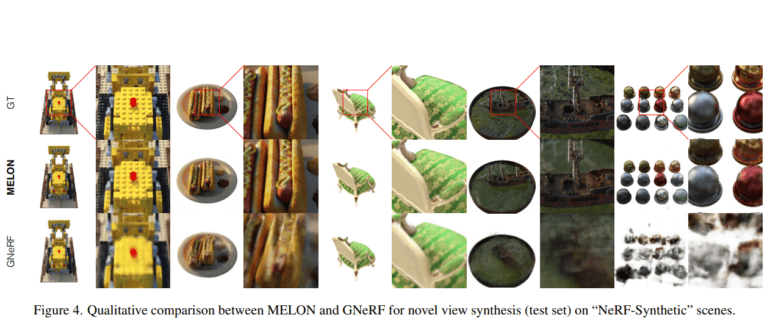- Stanford and Google AI introduced MELON, an AI technique for reconstructing 3D objects from 2D images without prior knowledge of camera poses.
- MELON addresses the challenge of pose inference in 3D reconstruction by leveraging a lightweight CNN encoder and introducing a modulo loss to account for object symmetries.
- Unlike previous methods, MELON eliminates the need for approximate pose initializations, complex training schemes, or pre-training on labeled data.
- Key techniques include a dynamically trained CNN encoder for pose regression and a modulo loss mechanism for considering pseudo symmetries of objects.
- Evaluation on the NeRF Synthetic dataset demonstrates MELON’s ability to converge to accurate poses and generate high-fidelity novel views from noisy, unposed images.
Main AI News:
The translation of 2D images into accurate 3D models poses a challenge for computers, contrasting with the ease at which humans can infer object shapes. This hurdle, known as pose inference, holds significant implications for various domains such as e-commerce 3D modeling and autonomous vehicle navigation. Prior methodologies, whether reliant on pre-gathered camera poses or employing generative adversarial networks (GANs), have fallen short in achieving precise and efficient solutions. Stanford and Google AI researchers introduce MELON as a groundbreaking approach to overcoming the obstacle of reconstructing 3D objects from 2D images in the absence of known poses.
Traditionally, methods like Neural Radiance Fields (NeRF) or 3D Gaussian Splatting have excelled in reconstructing 3D objects with known camera poses. However, the complexity arises when these poses remain undisclosed, resulting in an ill-posed scenario. Previous endeavors, such as BARF or SAMURAI, leaned on initial pose estimations or intricate training methodologies involving GANs. In stark contrast, MELON presents a streamlined yet highly effective strategy. Leveraging a lightweight CNN encoder for pose regression and introducing a modulo loss that accounts for pseudo symmetries of an object, MELON achieves state-of-the-art accuracy in reconstructing 3D objects from unposed images. This groundbreaking approach obviates the necessity for approximate pose initializations, convoluted training strategies, or reliance on labeled data, positioning itself as a promising solution for pose inference in 3D reconstruction endeavors.
At the core of MELON’s methodology lie two pivotal techniques. Firstly, it employs a dynamically trained CNN encoder to predict camera poses from training images. This CNN, initialized from noise and devoid of pre-training, effectively guides the optimization process by aligning similar-looking images to similar poses. Secondly, MELON introduces a modulo loss mechanism that simultaneously accounts for pseudo symmetries of an object. Rendering the object from a fixed set of viewpoints for each training image and backpropagating the loss solely through the viewpoint that best matches the training image enables MELON to tackle the ill-posed nature of the problem efficiently. Furthermore, by seamlessly integrating these techniques into standard NeRF training, MELON simplifies the process while yielding competitive outcomes. Evaluation on the NeRF Synthetic dataset underscores MELON’s ability to rapidly converge to precise poses and produce novel views with remarkable fidelity, even from exceedingly noisy, unposed images.
Conclusion:
MELON’s innovative approach to 3D object reconstruction represents a significant leap forward in the field. By simplifying the process and achieving competitive results without the need for complex training schemes or labeled data, MELON opens up new possibilities for applications in e-commerce, autonomous vehicles, and beyond. This advancement underscores the growing potential of AI techniques to revolutionize various industries reliant on accurate 3D modeling and visualization. Businesses should take note of MELON’s capabilities and consider integrating such cutting-edge technologies into their workflows to stay ahead in a rapidly evolving market.

